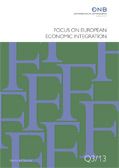Focus on European Economic Integration Q3/23
 OeNB
OeNB
- Erschienen:
- August 2023
 OeNB
OeNB
Are Phillips curves in CESEE still alive and well behaved? (PDF, 1,5 MB) Huber, Schreiner. This paper estimates Phillips curve relationships using nonparametric vector autoregressions for four Central, Eastern and Southeastern European (CESEE) economies. The novel feature of our model, which builds on Bayesian additive regression trees, is that it allows for unveiling possible asymmetries with respect to the size and sign of structural shocks. We simulate how unexpected movements in the unemployment rate impact inflation measures across the countries under consideration. We provide evidence that the reactions of inflation to labor market shocks are highly asymmetric: Small shocks trigger no statistically significant response of inflation whereas larger shocks induce strong, significant and persistent reactions for all countries in our sample. When focusing on differences between positive and negative unemployment shocks, we find that benign shocks lead to stronger price reactions than adverse movements in unemployment rates. These results all highlight substantial nonlinearities in the dynamic relationship between unemployment rates and inflation rates. en Phillips correlation, Bayesian vector autoregressions, business cycle shocks, asymmetries E31, E32, E50 09.08.2023, 00:00:00
Dedollarization efforts in Russia’s foreign trade against the backdrop of Russia’s war in Ukraine and intensifying Western sanctions (2013–2023) (PDF, 1,9 MB) Barisitz, Evdokimova. Dedollarization trends in Russia’s foreign trade have accelerated profoundly since Russia invaded Ukraine in 2022. Efforts to dedollarize date back to 2014, when Russia’s annexation of Crimea triggered the first sanctions. In the following eight years, the US dollar share in Russia’s foreign trade with its main trading partners dropped, albeit to varying degrees. Opportunities to dedollarize were smaller for Russian exports than for imports as Russian exports are dominated by commodities, which are historically mostly traded in hard currencies. Prior to 2022, the euro was deemed a relatively secure alternative to the US dollar and often replaced it as dedollarization unfolded. This strategy, however, limited genuine risk diversification once the United States and the European Union massively tightened their sanctions against Russia in 2022 in a synchronized way. Heightened difficulties and risks in processing US dollar and euro payments prompted a rapid shift to national currencies in Russia’s foreign trade. As of spring 2023, about 60% of Russia’s foreign trade was settled in Russian ruble and renminbi-yuan, compared to an average of around 20% in early 2022. Numerous initiatives regarding settlements in Turkish lira, United Arab Emirates dirham and Indian rupee were announced in 2022 and continue to be pursued in 2023, but financial infrastructure limitations have so far prevented any major breakthrough. These shortcomings may gradually be tackled though, creating opportunities for further invoicing currency diversification. Still, we do not consider these rapid shifts in Russia’s foreign trade invoicing a major threat to the predominance of the US dollar and the euro in global trade. On a regional level, however, a degree of currency fragmentation appears possible or likely. en dedollarization, currency fragmentation, foreign trade invoicing, Russian ruble, sanctions, trade settlement in national currencies, renminbi-yuan F19, F31, F42 09.08.2023, 00:00:00
91st East Jour Fixe. Housing markets in Austria and CESEE: homing in on prices, affordability and financial stability (PDF, 298 kB) en 09.08.2023, 00:00:00
Referees for Focus on European Economic Integration 2020−2023 (PDF, 290 kB) en 24.08.2023, 00:00:00